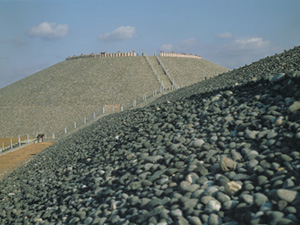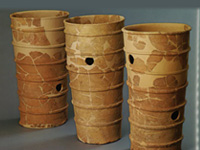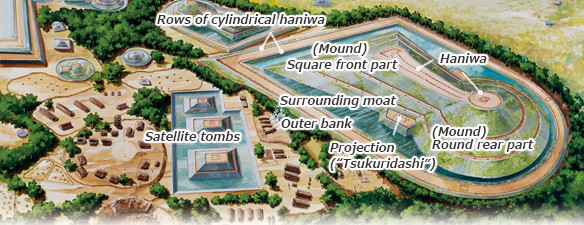What are kofun?
 Goshikizuka Kofun
Goshikizuka Kofun
(Kobe City Board of Education)-
A "kofun" is a mounded tomb made by piling earth, with the burial chamber inside the mound. Tombs of this type were common in the Japanese archipelago for about 400 years from the second half of the 3rd century AD.
Mounded tombs created during this period in particular are called kofun in Japanese. They were built by people of high standing in the social hierarchy of the time. Sometimes the kofun was surrounded by a water-filled moat.
In some cases, the slopes of the mound were covered with "fukiishi" cladding stones. This may have been for decorative purposes or to prevent the mound from collapsing.
Some burial mounds had two or three tiers, and some were surrounded by a double or a triple moat.
Kofun are also varied in planar shape, when seen from above. Some resemble a keyhole ("zempo-koen-fun" in Japanese), while others are circular ("empun") or square ("hofun"). They also vary considerably in size, from smaller ones measuring around 10 meters to giant ones extending for more than 400 meters.
 Cylindrical haniwa
Cylindrical haniwa
(excavated from Gobyoyama Kofun)-
Many of the larger keyhole-shaped kofun are decorated by "haniwa" (earthenware funerary sculptures)* lined up on the flat terraces of their mounds or banks, etc.
The mound contains the burial chamber, which often contains grave goods. These can help us estimate the wealth, power, and other characteristics of the buried person during their lifetime.
As such, kofun are more like social records than mere graves. The period when these mounded tombs were constructed in Japan is called the "Kofun period."
-
*What are haniwa?
Terracotta objects made of fired clay. The most common shape is the cylindrical haniwa. Along with the shape of the mound, the structure of the burial chamber, and the type of grave goods, the characteristics of cylindrical haniwa can provide clues to the dating of a kofun.
 Parts of a kofun
Parts of a kofun

- * For more detailed information on kofun shapes, see Various shapes of kofun.
 Looking at the historical background
Looking at the historical background
With the arrival of the Yayoi culture based on wet rice farming, people's lives drifted away from the so-called "hunter-gatherer economy" and closer to one focused on a "production economy." This change in the mode of subsistence led to the formation of settlements around rice paddies. As these settlements became more and more integrated, embryonic polities known as "kuni" came into being.
In the Middle Yayoi period, the ruling elite of these polities started to construct burial mounds. Then, toward the end of the Late Yayoi period (in the latter half of the 2nd century AD), mounds with distinct regional characteristics started to appear.
It was in the Kofun period, finally, that the standardized mounded tombs called kofun came to be constructed. Though based on the earlier burial mounds, these kofun lacked distinct regional characteristics.
Large-scale kofun from the Early Kofun period were extremely homogenous in the shape of their mounds, the structure of their burial chambers, the combination of grave goods, and other features. The same characteristics can be found in kofun over a very wide area, stretching from Kyushu in the west to Kanto and southern Tohoku in the east, with its center in the Kinki region.
As such, the emergence of kofun is said to reflect the creation of a broad confederation of local elite groups.


